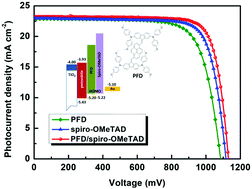A new molecular material as a dopant-free hole-transporting layer for stable perovskite solar cells†
Abstract
In this work, a new small molecular material, 9,9'-(pyrene-1,6-diyldimethylylidene)bis[N,N,N′,N′-tetrakis(4-methoxyphenyl)-9H-fluorene-2,7-diamine] (PFD), as a hole-transporting layer was designed for perovskite solar cells (PSCs). PFD has a rigid and flat pyrene unit as the central building block and a symmetric structure to increase the conjugation degree for better carrier conductivity. A power conversion efficiency (PCE) of 18.6% was achieved for PSC based on undoped PFD. When spiro-OMeTAD is further introduced on the top of PFD (PFD/spiro-OMeTAD), a PCE of 21.02% was achieved with a steady-state efficiency of 19.92%, revealing that PFD as an interfacial layer could restrain carrier recombination. Unencapsulated devices based on PFD or PFD/spiro-OMeTAD exhibit excellent stability including long-term stability for over 1400 h under ambient condition, and moisture stability under the “Double 60 program” test simultaneously at 60% RH and 60 °C in air. Besides, no obvious degradation was found for the PFD/spiro-OMeTAD device over 200 h under continuous illumination at the maximum power point tracking (MPPT) in N2 atmosphere. It is thus suggested that PFD could be a promising dopant-free HTM for PSCs, and also acts as an interface layer to suppress the carrier recombination to further improve the device performance.



 Please wait while we load your content...
Please wait while we load your content...